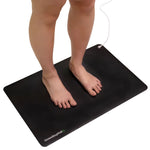How Grounding Affects Cortisol Levels and Stress Response?
por John Sildura en Sep 10, 2025

Grounding, also known as Earthing, is more than just walking barefoot. It’s a scientifically recognized way to restore the body’s natural electrical balance, regulate stress hormones, and improve well-being. At GroundingWell, we help people reconnect with nature’s stabilizing energy, promoting a calmer, healthier, and more centered life. The science behind grounding reveals a direct link between the Earth’s electrons and your body’s stress response system.
Table of Contents
- Key Takeaways
- Understanding Cortisol and the Stress Response
- What is Grounding?
- The Science Behind Grounding and Cortisol
- How Grounding Balances the Body’s Stress Response?
- Practical Ways to Incorporate Grounding into Your Routine
- The Long-Term Effects of Grounding on Stress and Wellness
- Conclusion
- FAQs:
Key Takeaways
- Grounding lowers cortisol, promoting calm and emotional balance
- Physical contact with the Earth restores the body’s natural rhythm
- Studies show improved sleep, reduced inflammation, and better mood regulation
- Grounding products extend these benefits indoors year-round
- Consistent practice enhances resilience against daily stress
Understanding Cortisol and the Stress Response
Cortisol is often referred to as the “stress hormone” because its release is triggered by stress. When you encounter a stressful situation, whether it’s physical (like a workout) or psychological (like a work deadline), your body activates the “fight or flight” response. This response is designed to help you deal with immediate threats by preparing your body for action. In this process, cortisol is released into the bloodstream to increase energy, improve alertness, and suppress non-essential bodily functions, like digestion or immune response.
However, while cortisol is vital for short-term survival, chronic stress can lead to elevated cortisol levels over time, which can have damaging effects. High cortisol levels are associated with a variety of health issues, such as:
- Fatigue: Over time, sustained high cortisol can lead to adrenal fatigue, a condition where the adrenal glands become less efficient in producing cortisol, leading to feelings of tiredness and low energy.
- Weight Gain: Elevated cortisol levels are often linked to increased appetite, particularly for comfort foods, and the accumulation of belly fat.
- Weakened Immune System: Chronic high cortisol can suppress immune function, making the body more susceptible to infections.
- Mental Health Issues: Prolonged stress and high cortisol levels are also linked to anxiety, depression, and difficulty concentrating.
What is Grounding?
Grounding, also called earthing, is the practice of connecting physically with the Earth’s surface by walking barefoot on natural ground, such as grass, dirt, or sand. The Earth carries a subtle negative charge, and proponents of grounding believe that making direct contact with the Earth allows the body to absorb these electrons, which can have various health benefits. Grounding may also refer to using grounding devices, such as mats or sheets that are connected to the Earth through a grounding rod or electrical outlet that replicate the effects of walking barefoot on natural surfaces.
The idea behind grounding is based on the concept that the Earth’s negative charge acts as a natural antioxidant, neutralizing free radicals (unstable molecules that can cause cellular damage). By connecting with the Earth, grounding is thought to help reduce inflammation, improve sleep, and enhance overall well-being.
The Science Behind Grounding and Cortisol
Grounding helps restore homeostasis, reducing excessive cortisol production through physical contact with the Earth’s surface. The human body conducts energy, and when you touch the ground, through grass, soil, sand, or water, free electrons are absorbed, which may help neutralize free radicals and balance the nervous system.
Research found that grounding can normalize daily cortisol rhythms, particularly in people under chronic stress. So, how exactly does grounding influence cortisol levels and the body’s stress response? While the research on grounding is still relatively new, a number of studies have explored its potential effects on stress reduction and hormonal balance. Here’s what scientists have discovered so far:
1. Reduction in Cortisol Levels
One of the most intriguing findings regarding grounding is its potential to lower cortisol levels. In several studies, participants who practiced grounding for extended periods showed a significant decrease in their cortisol levels. In a study published in the Journal of Environmental and Public Health, participants who grounded themselves by walking barefoot on grass for just 30 minutes a day showed a reduction in cortisol levels, leading to improved mood and reduced stress.
The mechanism behind this reduction in cortisol may be related to the Earth’s natural electrical field. When the body is in contact with the Earth, electrons are thought to flow into the body, which may help restore balance to the autonomic nervous system, reducing the body’s overall stress response and the need for excessive cortisol production.
2. Improved Heart Rate Variability (HRV)
Grounding has also been shown to improve heart rate variability (HRV), a key indicator of the body’s stress response and overall health. HRV refers to the variation in the time interval between heartbeats. A higher HRV is generally associated with better stress resilience and a more balanced autonomic nervous system. When the body is in a state of chronic stress, HRV decreases, and the sympathetic nervous system (responsible for the “fight or flight” response) becomes overactive.
Grounding has been found to increase HRV, which suggests that it helps activate the parasympathetic nervous system (the “rest and digest” system). This balance between the sympathetic and parasympathetic systems can help mitigate the stress response, reduce cortisol production, and promote relaxation.
3. Reduction in Inflammation
Chronic inflammation is often linked to elevated cortisol levels and various stress-related health problems. Grounding has been shown to reduce markers of inflammation, such as C-reactive protein (CRP), in the body. Since inflammation is a key contributor to the body’s stress response, grounding may help lower cortisol levels indirectly by reducing the inflammatory response.
A study published in the Journal of Alternative and Complementary Medicine demonstrated that grounding reduced inflammation in participants who suffered from chronic pain, which is often associated with prolonged stress and elevated cortisol. By reducing inflammation, grounding may help prevent the overproduction of cortisol triggered by the body’s immune response.
4. Improved Sleep Quality
Sleep disturbances are common among individuals who experience chronic stress and high cortisol levels. Elevated cortisol, especially in the evening, can interfere with the body’s ability to relax and fall asleep. Several studies have found that grounding may improve sleep quality by helping to regulate cortisol levels throughout the day.
In one study, participants who practiced grounding at night experienced a significant improvement in sleep quality, with a marked reduction in cortisol levels by morning. Grounding at night may help reset the body’s circadian rhythm, leading to more restful sleep and a reduction in the stress hormone cortisol.
How Grounding Balances the Body’s Stress Response?
When the body experiences stress, it triggers the hypothalamic-pituitary-adrenal (HPA) axis, signaling the release of cortisol. Chronic activation of this system can cause anxiety, insomnia, and inflammation.
Grounding interrupts this cycle by promoting parasympathetic (rest-and-digest) activation. Essentially, it helps your body switch from “fight or flight” to “restore and recover.”
Here’s how it works:
- Reduces Inflammation: Grounding may reduce oxidative stress that contributes to inflammation and cortisol overproduction.
- Improves Sleep Quality: Balanced cortisol levels help the body maintain healthier circadian rhythms.
- Enhances Heart Rate Variability (HRV): A sign of reduced stress and better autonomic balance.
- Supports Emotional Stability: Lower cortisol often correlates with a calmer, more resilient mood.
Practical Ways to Incorporate Grounding into Your Routine
Grounding doesn’t require major lifestyle changes, just consistent contact with the Earth or conductive grounding tools. If you’re interested in reaping the stress-reducing benefits of grounding, there are a few easy ways to incorporate it into your daily life:
- Walk barefoot outdoors: Spend at least 20-30 minutes a day walking barefoot on natural surfaces such as grass, sand, or soil. This is the simplest and most direct way to experience grounding.
- Use grounding mats or sheets: If you’re unable to go outside, you can use grounding devices like grounding mats, sheets, or bands that connect to the Earth’s energy. These devices are designed to mimic the effects of walking barefoot outdoors.
- Practice mindfulness while grounding: To enhance the benefits of grounding, take a moment to practice mindfulness while you’re outside. Breathe deeply, focus on your surroundings, and allow yourself to fully relax while connecting with the Earth.
The Long-Term Effects of Grounding on Stress and Wellness
Regular grounding helps establish long-term stress resilience. Over time, users report fewer cortisol spikes, better energy flow, and a deeper sense of emotional stability.
By maintaining electrical balance, the body becomes less reactive to external stressors. This harmony can:
- Support cardiovascular function.
- Improve immune response.
- Enhance clarity, focus, and overall vitality.
For a detailed overview of grounding research, see Frontiers in Psychology for emerging scientific perspectives on bioelectrical regulation and stress.
Conclusion
Stress is inevitable, but imbalance doesn’t have to be. Grounding offers a simple, natural way to support your body’s hormonal stability and emotional well-being. Whether through nature walks or grounding technology, reconnecting with the Earth can help realign your internal rhythm. GroundingWell empowers people to bring nature’s healing energy into modern life. Contact us today and discover how grounding can transform your stress response, one step or breath at a time.
FAQs:
How does grounding reduce cortisol levels?
By restoring electrical balance in the body, grounding reduces inflammation and supports parasympathetic activation, leading to lower cortisol output.
How long does it take to see results from grounding?
Many people report feeling calmer within days, while measurable cortisol improvements typically occur after 2–4 weeks of consistent grounding.
Can grounding help with sleep problems?
Yes. Studies show that grounding helps normalize cortisol rhythms, improving both sleep quality and duration naturally.
Do grounding mats work the same as walking barefoot?
Yes, when connected properly, grounding mats and sheets provide a similar electrical connection to the Earth’s surface as walking barefoot outdoors.
Is grounding scientifically proven?
Multiple peer-reviewed studies, including those published in the Journal of Environmental and Public Health, support grounding’s impact on cortisol, inflammation, and stress recovery.
Can grounding be practiced indoors?
Absolutely. Using GroundingWell’s grounding products allows you to experience the benefits of grounding even indoors, day or night.









